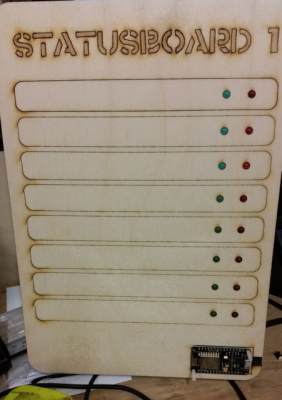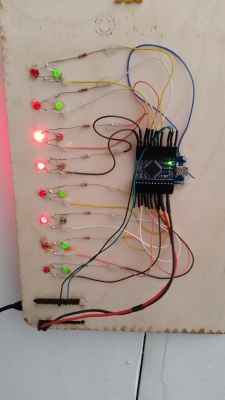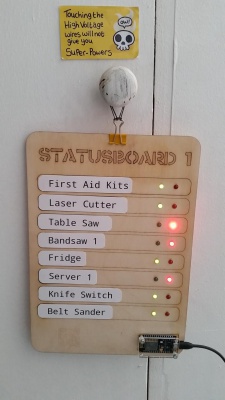Status Boards
| Status Boards | |
|---|---|
| Primary Contact | Michael Erskine |
| Created | 11/03/2016 |
Simple means of showing status of Hackspace stuff on web and physical boards.
- NodeMCU (ESP8226) with Arduino core for WiFi-enabled status board
- NodeJS server for HTTP access
- a good starter project for the NodeMCU_v2
- open source software on GitHub https://github.com/msemtd/nodemcu-statusboard
- Physical Prototype
-
First A4 lasercut prototype with 8 bits of data
-
prototype back showing ProMicro and wiring
-
functional prototype running with sample data
The driving of the 16 LEDs poses an interesting problem due to the limited number of digital outputs on the NodeMCU: we are looking for a simple low-cost solution so after looking at various ICs to perform the task I decided to throw in another inexpensive micro with plenty of I/O and control it with I2C, serial or similar.
Using a cheap ProMicro for I/O
The NodeMCU can tell the ProMicro what outputs to drive with a simple serial protocol: -
- ASCII for human convenience and same parsing code on both micros
- same interface on both UARTS - USB and HW for simplicity and testing
- The ESP8266-E is not 5v tolerant on the UART so I shall use a voltage divider
Power Profile
For my first tests I used a cheap 18650 power bank that one would normally use for recharging a mobile phone when off grid. It ran for less than 24hrs but I was not sure of the initial charge. Anyhow, there's no overarching need for this device to be battery powered so I will probably just run it from a spare mains phone charger but it has got me thinking about the power usage so I'm going to learn a little about that:-
- I'd like a generic current logger that I can attach to various devices - e.g. the SparkFun Low Current Sensor Breakout - ACS712 https://www.sparkfun.com/products/8883
- there may be ways of reducing the current draw for the LEDs
- The NodeMCU - is it a power hog?
- how efficient is our 5v ProMicro and can we save power by making simple mods and running it at 3.3v


